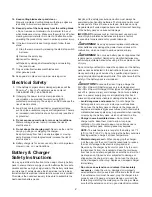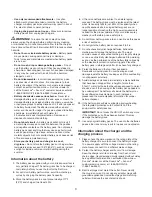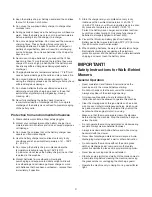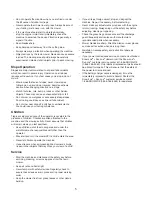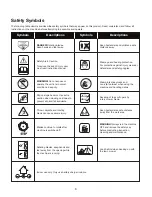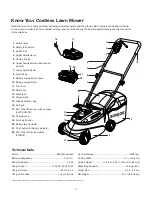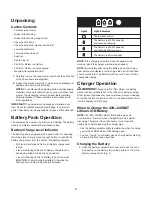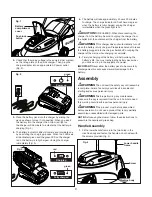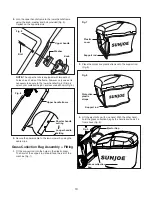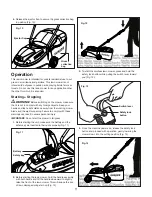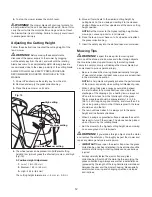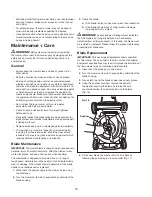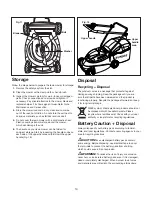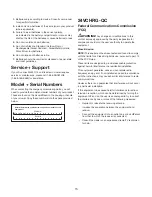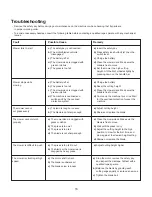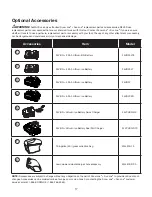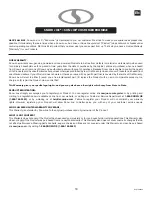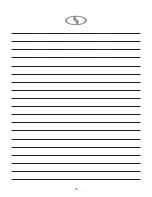
4
4. Keep the battery charger, battery pack(s) and the cordless
tool out of the reach of children.
5. Do not use the supplied battery charger to charge other
cordless tools.
6. During periods of heavy use, the battery pack will become
warm. Allow the battery pack to cool to room temperature
before inserting it into the charger to recharge.
7.
Do not overcharge batteries. Do not exceed the maximum
charging times. These charging times only apply to
discharged batteries. Frequent insertion of a charged or
partially charged battery pack will result in overcharging
and cell damage. Do not leave batteries in the charger for
days on end.
8.
Never use or charge batteries if you suspect that it has
been more than 12 months since the last time they were
charged. There is a high probability that the battery pack
has already suffered dangerous damage (exhaustive
discharge).
9.
Charging batteries at a temperature below 41°F (5°C) will
cause chemical damage to the cells and may cause a fire.
10.
Do not use batteries that have been exposed to heat
during the charging process, as the battery cells may have
suffered dangerous damage.
11.
Do not use batteries that have suffered curvature or
deformation during the charging process or those that
exhibit other atypical symptoms (gassing, hissing,
cracking, etc.).
12.
Never fully discharge the battery pack (maximum
recommended depth of discharge is 80%). A complete
discharge of the battery pack will lead to premature aging
of the battery cells.
Protection from environmental influences
1. Wear suitable work clothes. Wear safety goggles.
2. Protect your cordless tool and the battery charger from
moisture and rain. Moisture and rain can cause dangerous
cell damage.
3. Do not use the cordless tool or the battery charger near
vapors and flammable liquids.
4. Use the battery charger and cordless tools only in dry
conditions and at an ambient temperature of 41 – 105°F
(5 – 40.5°C).
5. Do not keep the battery charger in places where the
temperature is liable to reach over 104°F (40°C).
In particular, do not leave the battery charger in a car that
is parked in the sunshine.
6.
Protect batteries from overheating. Overloads,
overcharging and exposure to direct sunlight will result
in overheating and cell damage. Never charge or work
with batteries that have been overheated – replace them
immediately, if possible.
7. Store the charger and your cordless tool only in dry
locations with an ambient temperature of 40-105°F
(4.5-40.5°C). Store your lithium-ion battery pack in a cool,
dry place at a temperature of 50-68°F (10-20°C).
Protect the battery pack, charger and cordless tool from
humidity and direct sunlight. Only place fully charged
batteries in storage (charged to at least 40%).
8. Prevent the lithium-ion battery pack from freezing.
Battery packs that were stored below 32°F (0°C) for more
than 60 minutes must be discarded.
9. When handling batteries, be wary of electrostatic charge.
Electrostatic discharges can damage the electronic
protection system and the battery cells. Avoid electrostatic
charging and never touch the battery poles.
IMPORTANT!
Safety Instructions for Walk-Behind
Mowers
General Operation
• Read, understand and follow all instructions on the
machine and in the manual(s) before starting.
•
Do not put hands or feet near or under the machine.
Always stay clear of the discharge opening.
• Only responsible adults who are familiar with the
instructions should be allowed to operate this machine.
• Clear the mowing area of foreign objects such as rocks,
wire, toys and other miscellaneous articles, which could
be picked up and thrown by the blade. Stay behind the
handle when the engine (motor) is running.
•
Make sure that the mowing area is clear of bystanders
before starting the machine. Stop the machine if anyone
enters the area.
• Do not operate the machine barefooted or while wearing
sandals. Always wear substantial footwear.
• Always look down and behind before and while moving
backward with the mower.
• Never direct discharged material toward anyone. Avoid
discharging material against a wall or other obstruction.
• Do not operate the machine without the entire grass
catcher, discharge guard, rear guard or other safety
protective devices in place and in proper working order.
• Never leave a running machine unattended.
• Stop the engine (motor) and wait until the blade comes to
a complete stop before cleaning the machine, removing
the grass catcher or unclogging the discharge guard.
• Operate the machine only in daylight or in good artificial
light.


